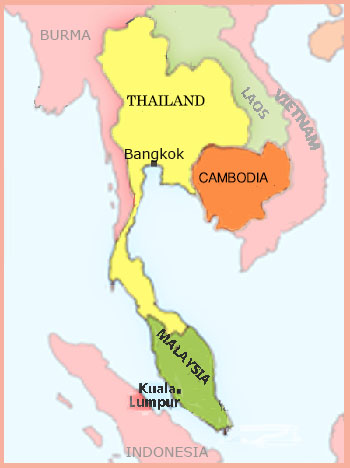|
|
|||||||||
|
|
|||||||||
|
|
Kuala Lumpur, 29 April, en route to Phnom Penh
KL has embraced the 21st century with an
enthusiastic building spree – everywhere we looked after our arrival at
KLIA2 yesterday showed buildings reaching, if not for the sky, then at least
for the top of the other buildings around.
Change of course cannot be stopped, but I'm a little sad to see the rows
of traditional two-storey shophouses
transformed into bigger cubes, columns and towers.
Notwithstanding that regret, we
are now safely ensconced in one such building, a 30-storey hotel, selected by
Dave for its nearness to the city's central railway hub KL Sentral. We
reached here just as the predictable afternoon rain started up, turning the
already busy roads into mobile road jams.
Although the walk to the hotel would have been less than 1km, we took a
taxi with our luggage, as navigating the roads around KL Sentral
on foot is only for the agile.
To call the road system here a
"system" is a bit of
a joke. KL started out 160 years
ago as a tin mining village. The foot tracks of the 1850s have been paved and
concreted into a winding, twisting convoluted nightmare, to be driven at the
certain risk of getting lost. We're
regular visitors here, but around KL Sentral and
Chinatown I'm still having to check a map, or these
days, a GPS.
Another
idiosyncrasy is
the love affair with air conditioning.. Air conditioning may have come to Malaysia only 50 or so years ago, but now, unless a
building is at 20 degrees, it's considered too warm. Last night when we arrived, we couldn't
persuade the room's aircon to lift itself to a more
habitable 25, so we had to turn it off so we could sleep We're here for only two nights, before heading tomorrow onto Phnom Penh, the capital of Cambodia, last visited by us more than 10 years ago. Today, we set out to explore the area around the hotel, which is largely unfamiliar to us. Brickfields is an inner city area, ripe for redevelopment. In the past, it's been somewhat notorious, possibly like the bad old days of Kings Cross, minus any open drugs trade (keep in mind the death penalty that's in force here). Now, big hotel chains and commercial office blocks are moving in to Brickfields, but a stroll around the fractured footpaths showed the old ways are still to be seen - but maybe for not much longer. One street had more than 20 businesses running printing services, including one shop which had printing presses dating back from god-knows-when, while another conducted mechanical repairs on the footpath. The tourist mecca of Bukit Bintang is another undergoing massive change - they're building a new light rail station here, and it is disrupting traffic completely. The main intersection is almost totally closed off and to get from one side to the other is a major expedition. A fairly new, rather nice plaza outside the Pavilion shopping mall at Bukit Bintang has had a short life - it's now being ripped up to make way for some very upscale premium apartments. The amount of building work going on makes me question whether or not Kuala Lumpur experienced any of the GFC at all - or if it's just recovering completely from it. So, wherever we looked, change is underway. Progress? Perhaps in most instances, but I do feel some regret for the disappearance of the old character of the city.
That old character was very much on display tonight at the Old China Cafe (above), where we went for dinner. We've eaten at this place on our last two visits here, and it evokes for us something of what I think Chinese cafes would have looked and felt like in the 1950s. Like last time, there was only one other Western couple there, so rightly or wrongly, we felt we were getting the "genuine" thing. This was the cafe where, last year, son-in-law Ashley asked for a durian dessert (durian being the revolting fruit loved by Asians, and called "the King of Fruits). The waiter ever-so-politely refused his order, saying "Oh no Sir, you would not like it". And that was that!! No durian dessert for Ashley. ........ Tomorrow, we leave KL, heading for a week in Cambodia, before 9 days in Thailand. |
Outside KL's most gracious and historic Catholic church, the Church of the Holy Rosary, at Brickfields.
20th century printing presses at Brickfields
|
|||||||
|
above: a traditionally dressed Malay customer talks to a mechanic at a footpath workshop right: work on the massive project of a train line through Bukit Bintang. |
/05%20Bukit%20Bintang%20work.jpg) |
above: looking down from our hotel room on a row of endangered shophouses. |
|||||||

/10%20Old%20China%20cafe%20int.jpg)

/01%20weather%20screen.jpg)
/03%20MB%20outside%20church.jpg)
/07%20printing%20works.jpg)
/09%20Old%20China%20cafe%20ext.jpg)
/04%20mechanic%20shop.jpg)
/08%20row%20of%20shop%20houses.jpg)